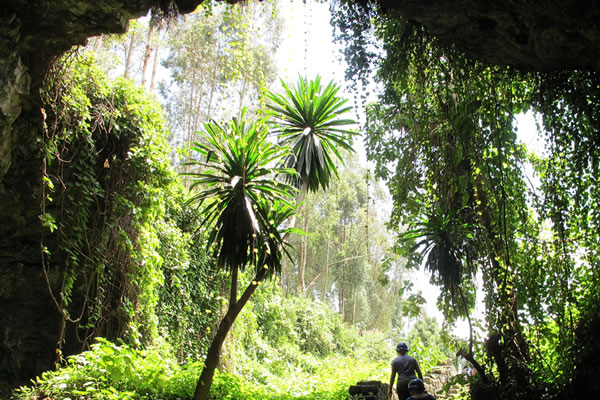Busasamana cave is one of the 52 Caves found in Rwanda, the land of a thousand hills, and was developed from Cenozoic Volcanic Rocks. This Cave is over one kilometer long and connects to a system of numerous other Caves within the Busasamana, Kazenze, and Mudende regions. This Cave leads to Kabari, Mugongo and Bwezi Caves.

Busasamana Cave, part of Musanze caves in Rwanda
This beauty is one of the least explored and is over 4.9 miles from the main Rubavu-Musanze Road close to Busasamana Catholic Parish. This spectacular Cave was formed from Centuries of geological activity involving the Virunga Volcanoes and has been in existence for millions of years.
Besides Busasamana Cave, there are many other beautiful Caves that can be explored during your Rwanda safari and these include the 1.25-mile-long Musanze Caves that have also existed for over 65 million years and are 21 kilometers inside. They are part of the Lava Basaltic layers from Mount Bisoke to Sabyinyo.
Another unmissable Cave is “Ubuvumo Bwibihonga”, a multi-level system of Parallel Lava Tubes known for being the longest Cave in the country.
Just close to Imbabazi Orphanage (Rosamond Carr property) is the stunning Mugongo Cave popular for providing exciting Caving experiences.
When to visit Busasamana Cave on Volcanoes
Busasamana Cave, just like most Caves in Rwanda is open all-year round but the time you visit might determine your overall experience. If you expect the least amount of crowds (quieter), explore the Cave during the wet season- between March and April or October to November. However, these months are generally rainy, hence pathways and Cave surroundings are muddy and slippery thus more challenging to maneuver through.
The perfect walking weather is in the months of December to February and June to September when pathways are drier and slippery. During this time of the year, rainfall levels are lower but expect huge crowds as most travelers prefer visiting during these months.
What to carry/wear for your tour
For your Busasamana Cave Tours, you should have a layer of warm clothing (long-sleeved shirts and safari pants), a flashlight/head torch for alternate flight source, gardening gloves for protecting your hands while you hold the Cave walls/floors during the hike, a reusable water bottle for refilling your drinking water, a backpack for carrying items needed during Cave tours, a first aid kit because minor accidents/falls are inevitable during Caving, energy-giving snacks, cave directions/map, sturdy hiking boots, cotton socks, a good camera, and many others.
